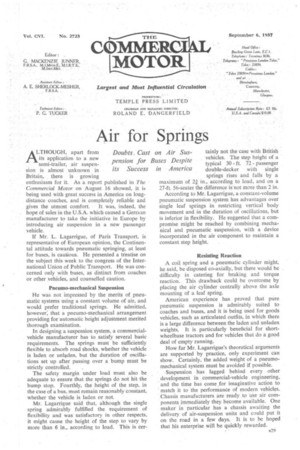Air for Springs
Page 35

If you've noticed an error in this article please click here to report it so we can fix it.
NTHOUGH, apart from its application to a new semi-trailer, air suspension is almost unknown in Britain, there is growing enthusiasm for it. As a report published in The Commercial Motor on August 16 showed, it is being used with great success in America on longdistance coaches, and is completely reliable and gives the utmost comfort. It was, indeed, the hope of sales in the U.S.A. which caused a Gernian manufacturer to take the initiative in Europe by introducing air suspension in a new passenger vehicle, If Mr. L. Lagarrigue, of Paris Transport, is representative of European opinion, the Continental attitude towards pneumatic springing, at least for buses, is cautious, He presented a treatise on the subject this week to the congress of the International Union of Public Transport. He was concerned only with buses, as distinct from coaches or other vehicles, and counselled caution.
Pneumo-mechanical Suspension He was not impressed by the merits of pneumatic systems using a constant volume of air, and would prefer traditional springs. He admitted, however; that a pneumo-mechanical arrangement providing for automatic height adjustment merited thorough examination.
In designing a suspension system, a commercialvehicle manufacturer has to satisfy several basic requirements. The springs must be sufficiently flexible to absorb road shocks, whether the vehicle is laden or unladen, but the duration of oscillations set up after passing over a bump must be strictly controlled.
The safety margin under load mint also be adequate to ensure that the springs do not hit the bump stop. Fourthly, the height of the step, in the case of a bus, must remain reasonably constant, whether the vehicle is laden or not.
Mr. Lagarrigue said that, although the single spring admirably fulfilled the requirement of flexibility and was satisfactory in other respects, it might cause the height of the step to vary by more than 6 in., according to load. This is cer tainly not the case with British vehicles. The step height of a typical 30 ft. 72passenger double-decker with single springs rises and falls by a maximum of 21. in., according to load, and on a 27-ft. 56-seater the difference is not more than 2 in.
According to Mr. Lagarrigue, a constant-volume pneumatic suspension system has advantages over single leaf springs in restricting vertical body movement and in the duration of oscillations, but is inferior in flexibility. He suggested that a compromise might be reached by combining mechanical and pneumatic suspension, with a device incorporated in the air component to maintain a constant step height.
Resisting Reaction A coil spring and a pneumatic cylinder might, he said, be disposed co-axially, but there would be difficulty in catering for braking and torque reaction. This drawback could be overcome by placing the air cylinder centrally above the axle mounting of a leaf spring.
American experience has proved that pure pneumatic suspension is admirably suited to coaches and buses, and it is being used for goods vehicles, such as articulated outfits, in which there is a large difference between the laden and unladen weights. It is particularly beneficial for shortwheelbase tractors and for vehicles that do a good deal of empty running.
How far Mr. Lagarrigue's theoretical arguments are supported by practice, only experiment can show. Certainly, the added weight of a pneumomechanical system must be avoided if possible.
Suspension has lagged behind every other development in commercial-vehicle engineering, and the time has come for imaginative action to match it to the performance of modern vehicles. Chassis manufacturers are ready to use air components immediately they become available. One maker in particular has a chassis awaiting the delivery of air-suspension units and could put it on the road in a few days. It is to be hoped that his enterprise will be quickly rewarded.




























































































































